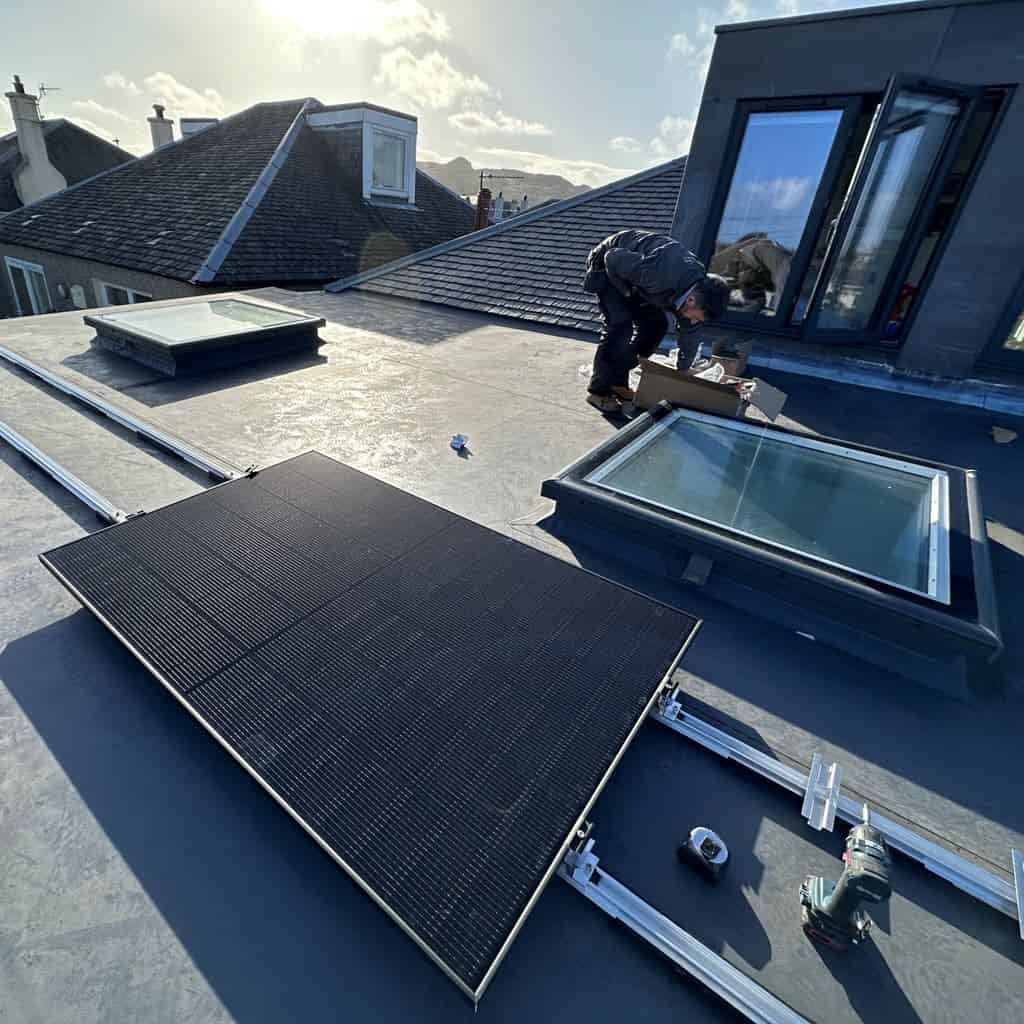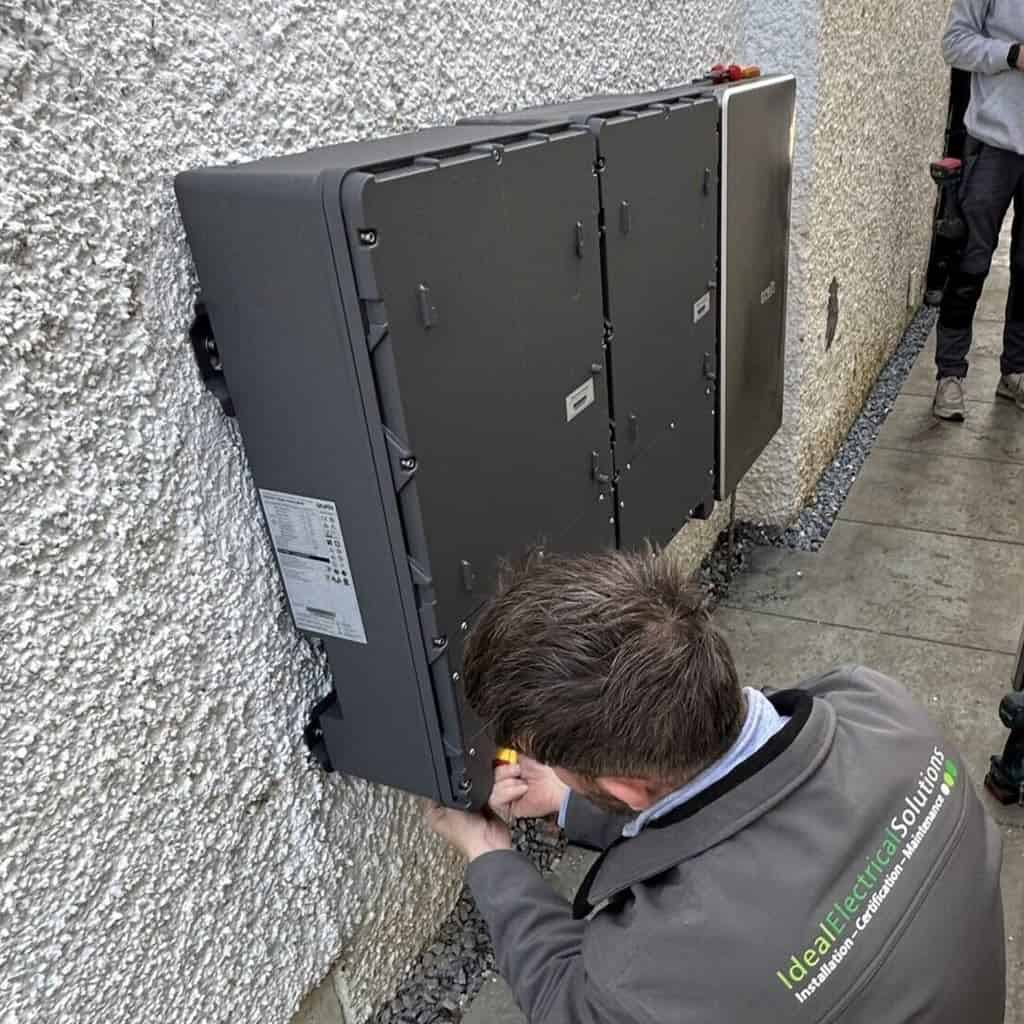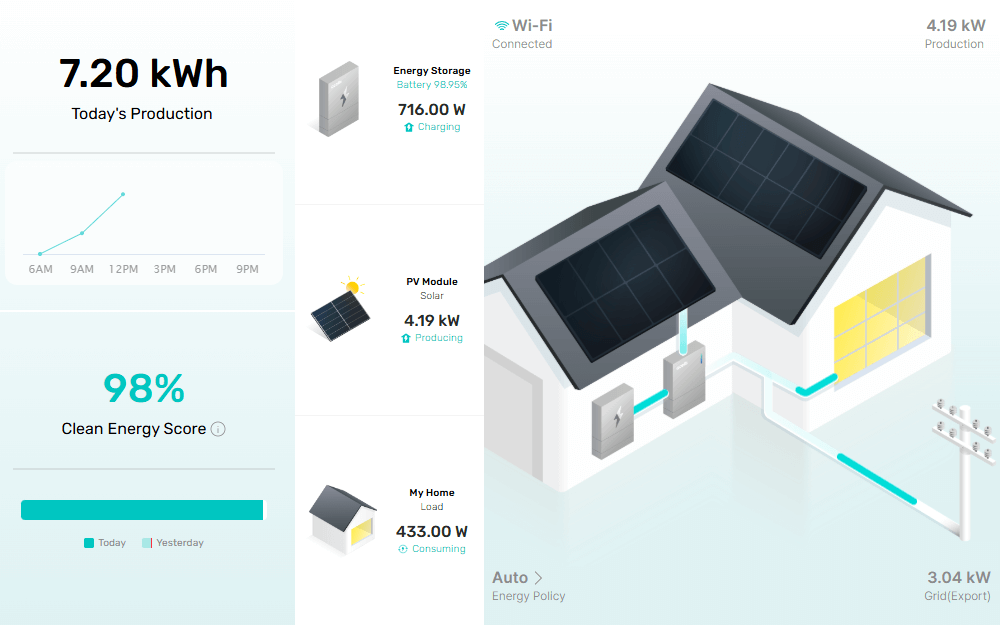Project Summary: Solar PV and Battery Storage
- Client: Homeowners with lovely extended bungalow in Craigentinny, Edinburgh EH7.
- Task: 14x solar panels & battery storage installation.
- Outcome: Reduction on yearly electric bills and longer-term ROI.
- Installation cost: The cost for installation of this 6.37 kWp solar gain and 13.72 kWh battery storage system is £12,000.
- Payback period: Around 7 years, with anticipated savings over 25 years of £38,000 based on today’s electricity rates.
The customer requirement was to reduce energy bills and future proof their home
The homeowner, living in a 1930’s bungalow in the Craigentinny area of Edinburgh (EH7 postal area), was facing high energy costs and wanted a long-term solution to reduce their electricity bills. They were looking for a renewables solution that would allow them to maximise self-generated solar power, store excess energy, minimise their reliance on the grid and future-proof their home.

An interesting flat roof and dormer challenge!
There are many areas around Edinburgh with these types of lovely bungalows and they present an interesting challenge when installing solar. As you can see from the drone photo we took during the survey, there isn’t a lot of suitable South facing space on the pitched roof (the 3 Velux windows in the attic conversion are on the South facing side of the roof).
This is frequent in other areas of Edinburgh too, like Blackhall, Craigleith etc, where builders like Miller homes built lovely bungalows during the 1920s and 1930s. Many of these bungalows, just like this one in Craigentinny, have had more recent attic conversions and the addition of dormers.
In this particular home a beautiful flat roof extension has also been added at the back to provide a more open plan living space and kitchen diner area. This somewhat changes the solar options and decision making process around the ideal placement and effectiveness of a solar solution.
Designing a solar system for a flat roof
We were asked “can we have solar panels on our flat roof?” and we explained that in practice flat roofs are just as viable and bring some advantages, such as being simpler to install and easier to maintain.
We recommended a 6.37 kWp solar PV system consisting of 14 high-efficiency solar panels, paired with a 13.72 kWh battery storage system to maximise energy efficiency and savings.
To accommodate the flat roof, we designed a specialised ballast system that required no fixings to the existing structure. This ensures a secure installation without compromising the integrity of the roof, eliminating any risk of future issues.
The homeowner agreed to proceed and we then installed a complete solar PV and battery storage system that was ideally tailored to their needs.


Installing solar panels on the flat roof and dormers …
The project began with the installation of 14 solar panels on the flat roof and dormers of the property. This solar PV installation ensured that the solar panels were positioned to ensure optimal sun exposure, allowing the system to generate the maximum amount of electricity throughout the year.
We installed solar panel optimisers on each panel to maximise energy generation. These devices ensure that each panel operates independently at its highest efficiency, preventing performance from being affected by shading or variations in sunlight exposure. Unlike traditional systems where the output of one underperforming panel can impact the entire array, optimisers allow each panel to function at its peak, increasing overall energy production and system reliability.
For the flat roof installation, we utilised a K2 ballast system, which securely fixed the solar panels in place without penetrating the existing roof structure. This non-invasive system was designed to withstand environmental factors and included wind load calculations to ensure long-term stability.
The design adhered to BS EN standards, with a failure consequence class of CC1 and a design working life of 25 years.
Installing the battery storage …
Next, we installed a high-capacity 13.72 kWh battery storage system. This solar battery storage system allows the homeowner to store excess solar energy generated during the day and use it in the evening or when sunlight is limited.
This greatly reduces reliance on expensive grid electricity.
To ensure the system was fully integrated into the home’s electrical infrastructure, we carried out an upgrade to the consumer unit. This upgrade was necessary to meet current regulations and ensure the safe operation of the new energy system.
A smart metering module was also installed, enabling exact monitoring of energy usage, charge cycles, and battery storage levels. This allows the homeowner to track their electricity generation and consumption in real-time.
Once fully installed, we conducted testing and commissioning and verified that all connections were secure and that the system was operating efficiently.
We provided all necessary electrical certificates and walked the homeowner through how to monitor and maintain their new solar and battery system.


The results – long-term savings and energy independence
With their new solar and battery storage system, the homeowner will significantly reduce their energy costs and reliance on the national grid. The system is expected to deliver the following benefits:
- Lower electricity bills: All year-round savings.
- Payback period: The homeowner will recover their investment in 7 years.
- Total savings: Over 25 years, the estimated savings amount to £38,000 based on today’s energy rates not including any export.
- Installation cost: The total cost for this solar PV and battery storage system was £12,000.
- Environmental impact: By switching to solar energy, the homeowner has significantly reduced their carbon footprint.
Within just one week during the winter months, the system generated over 145 kWh of solar energy, equating to approximately £37 in savings based on today’s electricity rates. This highlights the impressive year-round efficiency of the installation, even during periods of lower sunlight.
During the summer months, energy generation is expected to be significantly higher, ranging between 30-60 kWh per day. This substantial increase in production not only covers the homeowner’s daily energy needs but also provides an opportunity to export excess energy back to the grid through an export tariff.
With Octopus Energy’s Smart Export Guarantee (SEG), the homeowner can earn approximately 16p per kWh for surplus energy sent back to the grid. This means on a high-generation summer day, they could export up to 50 kWh, potentially earning £8 per day in additional savings. Over the course of the year, this ability to sell excess power helps further reduce overall electricity costs and accelerates the system’s return on investment.
Summary – a flat roof solar solution that reduces energy bills and gives long-term ROI
By combining self-consumption, battery storage, and grid exports, this installation ensures maximum financial benefits while promoting a more sustainable energy future.
Are you thinking about solar panels and battery storage for your home? To find out more contact Ideal Electrical using this form or give us a call on 0131 258 2750 for an informal chat about how you can reduce your energy costs and secure your home’s energy future.


1) I’m wondering what the advantage might be of more panels, generating a bigger surplus for sale to the grid?
2) Is it difficult to link calculations to a Community Energy mutual arrangement
(assuming the law about Community Benefit Societies isn’t significantly different in Scotland)?
Hi Alan,
Installing more panels can indeed generate a bigger surplus for sale to the grid, offering you a greater opportunity to offset your electricity bills or earn revenue through feed-in tariffs. It’s all about maximizing your renewable energy output based on your roof space and energy needs.
Linking calculations to a Community Energy mutual arrangement typically involves ensuring that your system’s output aligns with the community’s energy requirements. Regarding Scottish law, Community Benefit Societies are regulated similarly, focusing on local benefits and sustainability.
If you have more specific queries or want to discuss your options further, feel free to get in touch!